Poison from the Colorado potato beetle: how to defeat a voracious pest
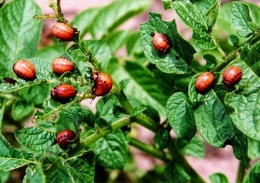
Colorado beetle - one of the most voracious pests of agricultural crops.
Possessing a great ability to restore population numbers, it is capable of occupying large areas and causing irreparable damage, primarily to potatoes.
Various poisons from the Colorado potato beetle are ineffective, since the pest develops immunity very quickly.
To effectively fight the voracious beetle, you need to know the development cycle and lifestyle of the indestructible insect.
Content:
- Description of the pest
- Clutches of the Colorado potato beetle and the fight against them
- Modern poison against the Colorado potato beetle
Description of the pest
At the beginning of the 19th century, during the development of Mexico, a beetle with black stripes on a red and yellow background was discovered. Each of the elytra had five stripes, for which the beetle received the name ten-lined.
In Mexico, in conditions of a limited number of edible plants, the beetle has adapted to feed on poisonous leaves tobacco and he had no wild nightshade or competitors in the fight for food.
And since the poisonous solanine alkaloids contained in these crops accumulated in the beetle’s tissues, it also had almost no natural enemies that consumed the beetle as food.

As Mexico was developed, the pest entered the American states of Arizona, Texas, and Nebraska. Here the pest got the opportunity to feed on potato plantings. The abundance of food stimulated population growth.People started talking about the beetle when, in 1859, countless numbers of them destroyed potato crops in Colorado.
Over the next five years, the pest not only managed to spread throughout North America, but also crossed the ocean on merchant ships and ended up in Europe.
European agronomists were still able to cope with the first outbreaks of defeat, but when the First World War was going on in Europe, the situation got out of control. The beetle adapted to new climatic conditions and began to reproduce successfully in European ones. It should be said that the insect overwinters in the soil at a depth of up to 30 cm. In cold winters with little snow, its population may decrease due to soil freezing.
A special feature of the insect is its ability to endure unfavorable conditions in a state of diapause - a kind of hibernation in which it can spend up to three years without coming to the surface. In the temperate climate of most Russian regions, the Colorado potato beetle produces one or two generations per season, in the southern regions - up to four.
Clutches of the Colorado potato beetle and the fight against them
Eggs are laid on the underside of nightshade leaves:
- potatoes
- eggplant
- peppers
- petunias
- tobacco
As soon as the larvae emerge from the eggs, they immediately begin to eat the leaves, right up to pupation, and when after 10 days the beetle emerges from the pupa, it also continues to eat the plants.
Video on how to get rid of the Colorado potato beetle:
It is completely impossible to defeat the Colorado potato beetle by mechanically destroying the beetle and its clutches, changing crop rotation, large gaps in fields with nightshade crops, or colonizing fields with predatory insects.
Here either genetics and genetic engineering or poisonous pesticides and biological products come to the rescue.
Modern poison against the Colorado potato beetle
The drug Bankol
In the fight against the Colorado potato beetle and its larvae, the drug bankol based on the substance bensultan has proven itself well.
The action of bankol is based on neurotoxic damage to larvae and adults. Beetles on treated plants lose interest in food, become inactive, are unable to stay on the plant and fall from it.
The drug in recommended doses is non-toxic to bees, fish and warm-blooded animals. Bankol acts both upon direct contact and by accumulating in plant leaves, causing the death of insects.
Therefore, as soon as the larvae emerge from the eggs and begin to feed on the treated plant, they die almost immediately.
This effect lasts 15 days. The drug is recommended for use on plantings potatoes twice per season.
The drug Mospilan
A contact insecticidal drug that causes disruption in the functioning of the beetle's nervous system, resulting in paralysis.
The drug spreads throughout all parts of the plant, making them dangerous to be eaten by the beetle and its larvae. The effect of mospilan does not even appear on the treated parts of potatoes and other plants.
Decis Profi drug
One of the effective drugs with minimal toxicity to humans, fish, birds, and animals.
An hour after treatment, it causes the death of the Colorado potato beetle, disrupting the conductivity of cell membranes and blocking the passage of nerve impulses. Effectiveness lasts for two weeks.
Drug Fastak
Causes almost instantaneous death of the Colorado potato beetle and its larvae. The undoubted advantage of the drug is its stability during precipitation.
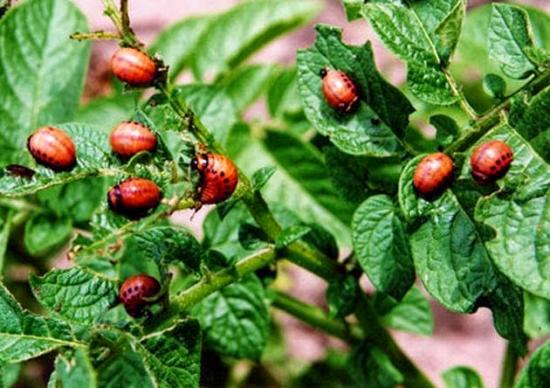
For potato plantings, it is recommended to apply twice no later than 20 days before harvesting.
In addition to the above remedies against the Colorado potato beetle, you can also use other pesticides:
- confidor
- commander
- tantrek
- intavir
- ram
- karate
Whatever poison is used against the Colorado potato beetle, it is important to follow the instructions for use and safety precautions when storing the product and treating nightshade crops with it.
Interesting information about the vegetable garden

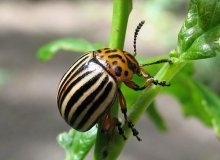
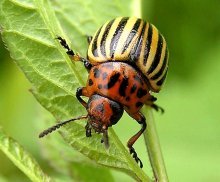
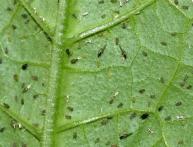
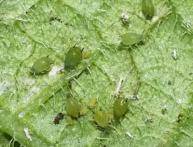
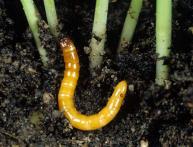
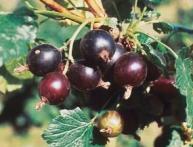
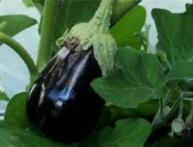

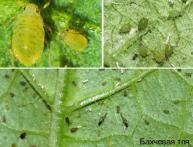
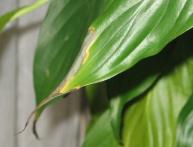
Comments
We have been using Confidor for several years now. True, one spraying is not enough - at least three are needed for all the beetles and larvae to die. We spray the potatoes once a month, since we cannot completely get rid of the beetle.